mytest
Books, eBooks, and more from Debito Arudou, Ph.D. (click on icon):
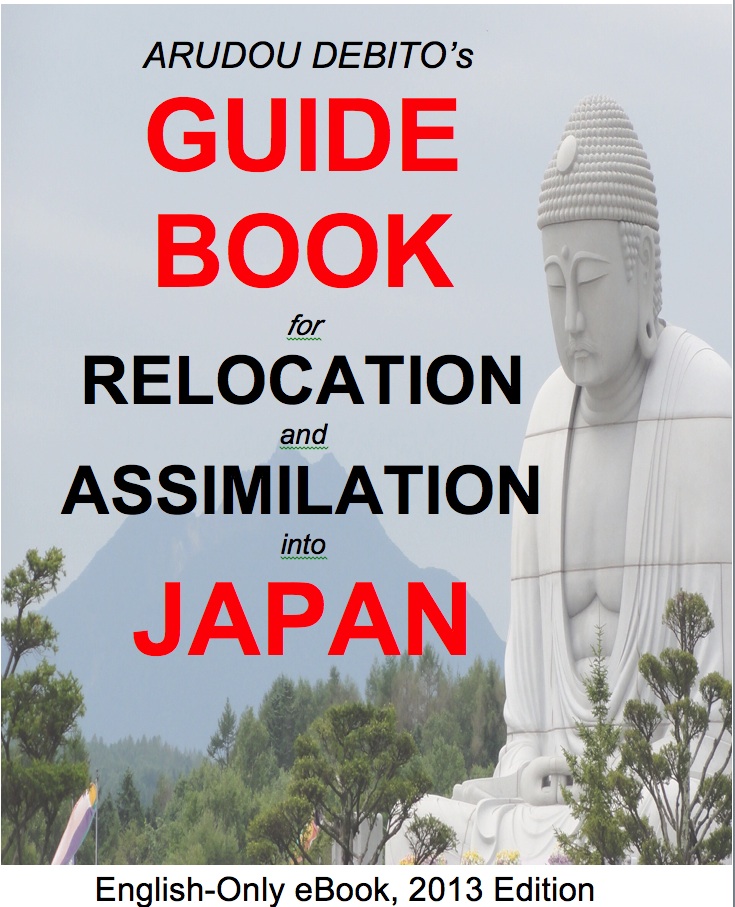
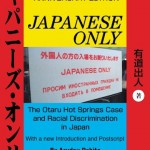
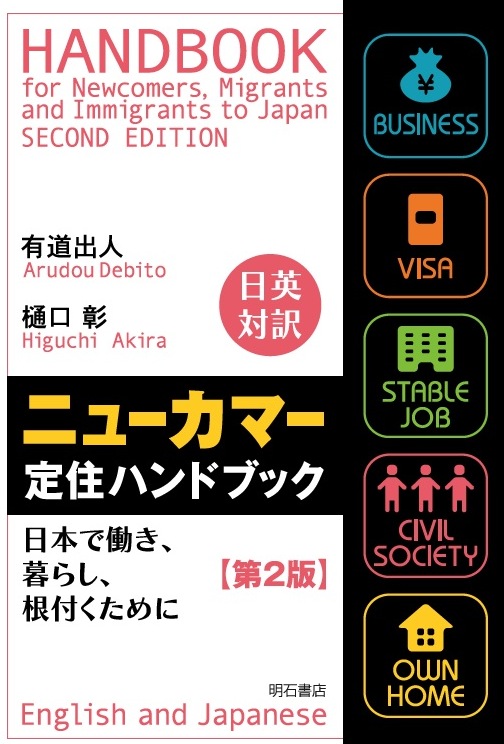


![]()


UPDATES ON TWITTER: arudoudebito
DEBITO.ORG PODCASTS on iTunes, subscribe free
“LIKE” US on Facebook at http://www.facebook.com/debitoorg
https://www.facebook.com/embeddedrcsmJapan
http://www.facebook.com/handbookimmigrants
https://www.facebook.com/JapaneseOnlyTheBook
https://www.facebook.com/BookInAppropriate
Hi Blog. We’ve talked numerous times before about GOJ-approved (and other) textbooks in Japan’s primary education (particularly in regards to teaching “morals“), and their issues with racializing “foreigners” and people of diversity in Japan. Here’s the latest version in a new textbook, from Debito.org Reader XY, who is facing an uphill battle in teaching his young child how to view diversity in society. Debito Arudou, Ph.D.
////////////////////////////
From: XY
Subject: Problematic depictions of race in a dōtoku textbook for first graders
Date: April 26, 2021
To: Debito Arudou <debito@debito.org>
Hi Debito,
Today I’m contacting you because I’ve to share something problematic concerning the dōtoku (morals) class taught in Japan’s schools. My child just entered primary school and because of the questionable reputation the dōtoku class gained during the last two decades, I put the dōtoku textbook under scrutiny. As I suspected it didn’t disappoint me and provided two sections I find highly problematic when it comes to race images and relations in Japan.
But first I want to provide the bibliography of the textbook in question.
Shōgaku Dōtoku: Yutaka na Kokoro 1-Nen, Tokyo: Kōbun Shoin, 2020 (“Primary School Morals: Having a Heart Full of Plenty, Year One”, approved by MEXT in 2019) (click on images to expand in browser).
The first two photos are of the cover and the imprint, including a list of authors.
And now to the two problematic sections I found.
The first one stretches from pages 26 to 29.
It shows a story of a lumberjack who lost his axe in a pond. A goddess appears from the pond, shows him a golden axe, and asks him if it’s his one. He declines. Next, she brings him a silver axe, but he declines again saying that his axe is made of iron. The goddess is impressed by his honesty and gives him his iron axe together with the golden and silver ones as reward for his honesty. The neighboring lumberjack hears what happened, gets envious, and wants those precious axes, too. He goes to the pond and throws his axe into the pond on purpose. The goddess appears and offers him a golden axe. The envious lumberjack immediately claims that this is his lost one, but the goddess knows that it’s a lie and disappears, leaving the envious lumberjack without any axe. The textbook then asks the pupils how they feel about the behavior of the envious, lying lumberjack.
The story is a classic and the questions raised are fair enough, but I think the depiction of the characters is literally begging for criticism. The goddess is obviously modelled after something stereotypically Ancient Greek, but that’s not a big deal. To me the problem lies within the looks of the two lumberjacks. While the honest one could pass as an ordinary J-salaryman if you draw him in a suit, the dishonest one looks like a stereotypical Western lumberjack, complete with a very pronounced large nose to convey the “proper” racial stereotype of a white person to first graders. Not very flattering.
The second problematic section stretches from pages 100 to 103.
It deals with a blonde, white foreign girl called Emma from Australia transferring to the class of the protagonist. But if you go on and read the text, you’ll quickly find out that this “foreign” girl (and the text blatantly says gaikoku no hito) from Australia is actually a “hāfu”, having an Australian father and a Japanese mother (tick the box for the stereotype of a white man marrying a J woman).
So, the girl isn’t a gaikoku no hito, at all, but would have Japanese citizenship by bloodline through her mother in the real world. A barefaced, unjust gaijinization of a certain type of birthright Japanese. The story goes on with the description how Emma marks correct answers (with a check rather than the Japanese circle) emphasizing differences and that Emma is not able to speak Japanese properly, yet (tick box for the next stereotype about “foreigner’s” language skills). The story concludes with the typical anticipation of the Japanese girl – the protagonist – looking forward to converse with Emma in English after the start of English classes.
I identified three major problematic points in total:
- Gross gaijinization of a birthright Japanese just because of having a foreign father instead of doing the morally correct thing and teach that the so-called “hāfu” are as Japanese as any “pure” Japanese.
- The claim that Emma is bad at Japanese because of her “foreignness”, which can easily proliferate the stereotype that “foreigners” can’t speak Japanese (properly), even if they have a Japanese parent (and therefore aren’t gaikokujin (or gaikoku no hito, wording that is more about origin than legal status) in the first place).
- A strong focus on differences rather than similarities as human beings no matter what race someone belongs to.
Overall an extraordinarily poor example, sidelining mixed-race Japanese to gaikokujin status and planting this legally false and socially outdated idea into the minds of first graders. A G7 member should do away with the proliferation of such bs. It’s 2021, not 1921.
In conclusion, I think that these two texts sneak in stereotypes into the minds of Japanese first graders that are detrimental to foreigners and international (racially diverse) Japanese. The first one subtly conveys a “foreigners can’t be trusted” kind of message, the second one treats legal Japanese with international heritage as genuine gaikokujin and overemphasizes differences over similarities, and also proliferates the obnoxious gaikokujin = blonde eigojin stereotype.
Best regards,
XY
======================
Do you like what you read on Debito.org? Want to help keep the archive active and support Debito.org’s activities? Please consider donating a little something. More details here. Or if you prefer something less complicated, just click on an advertisement below.
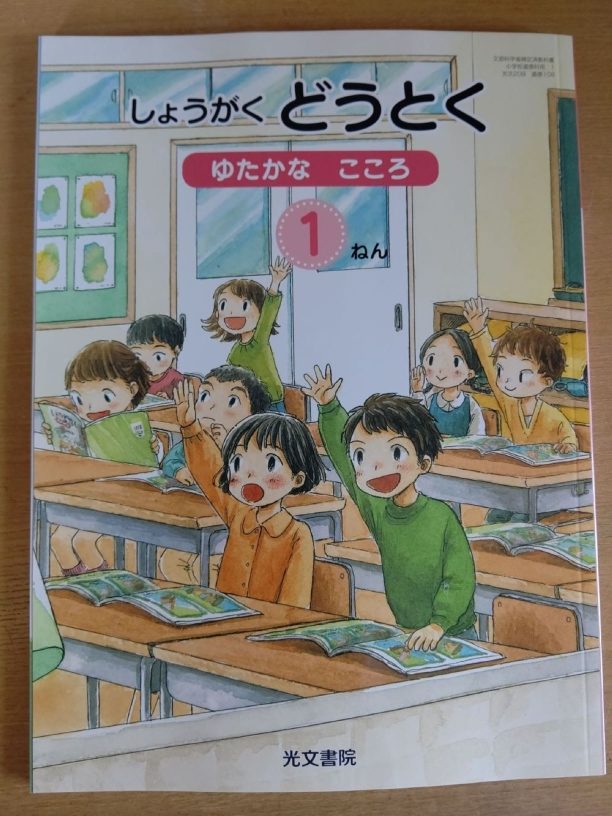
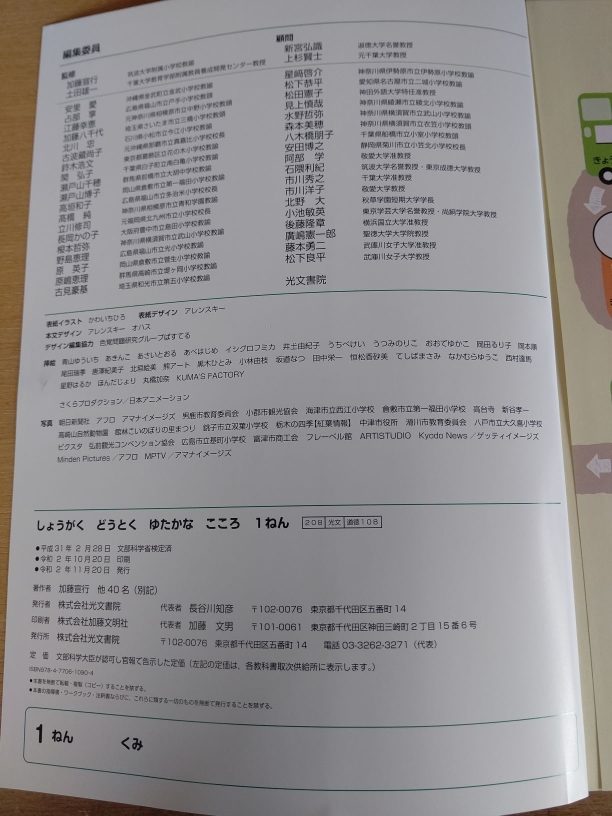
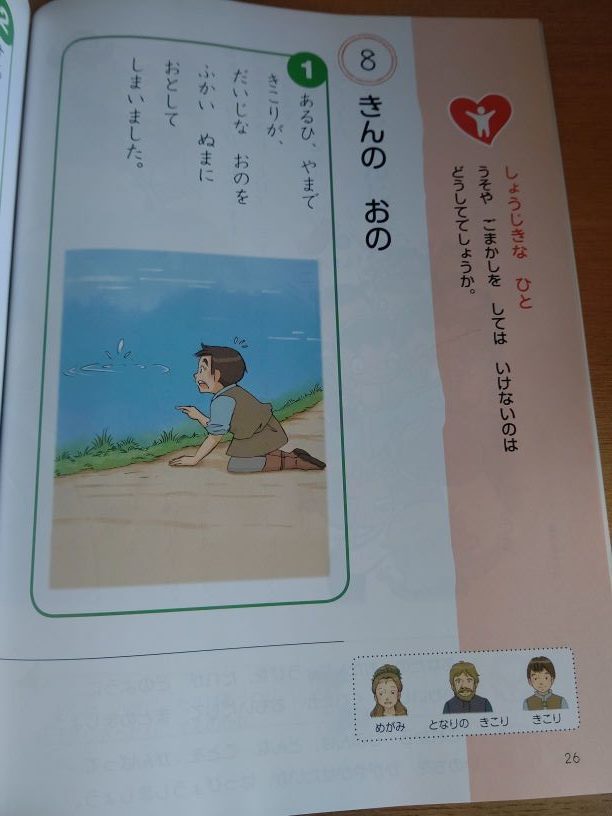
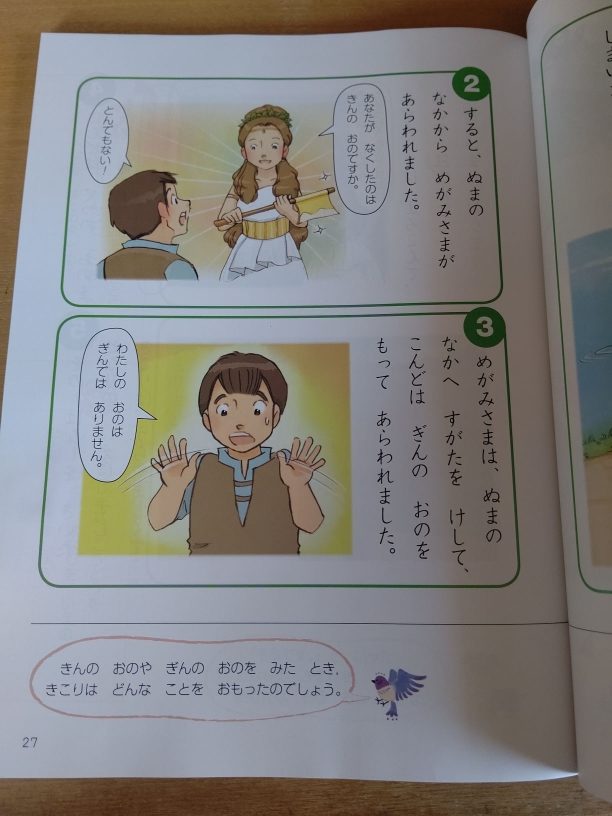
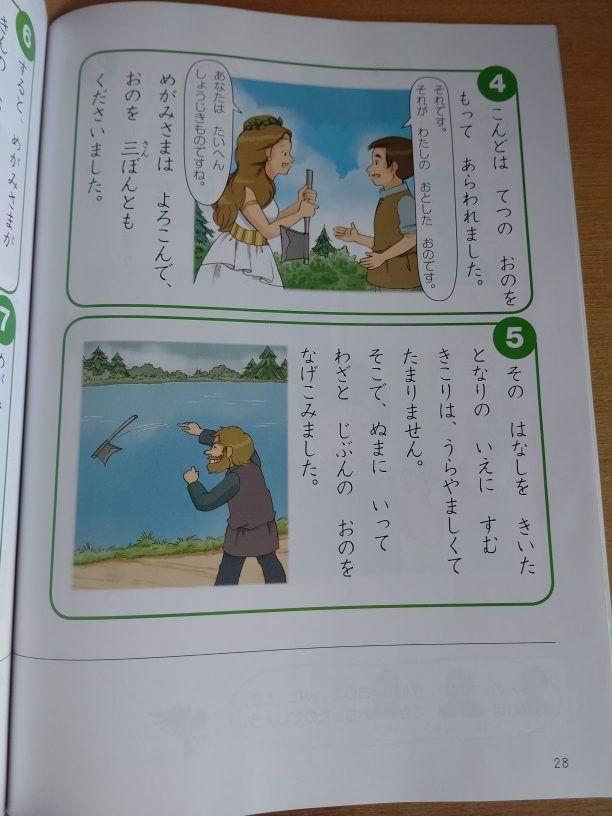
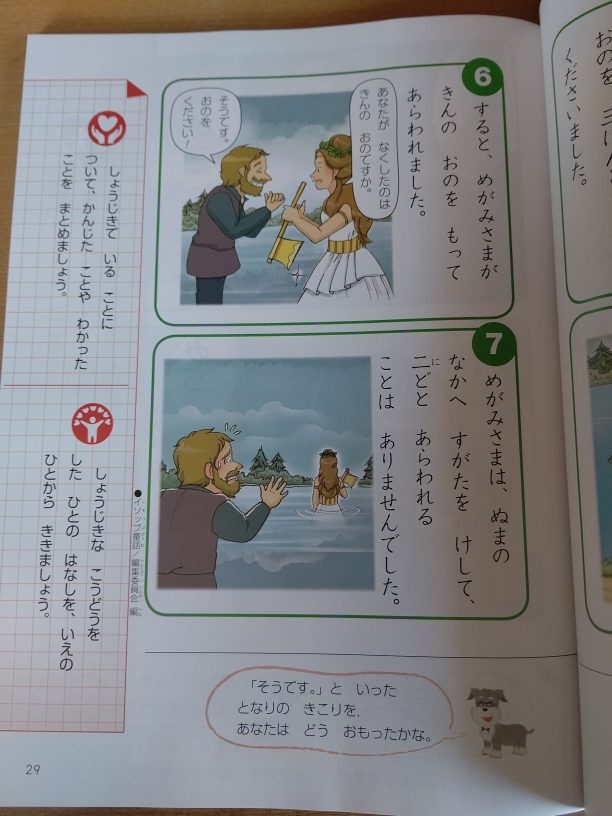
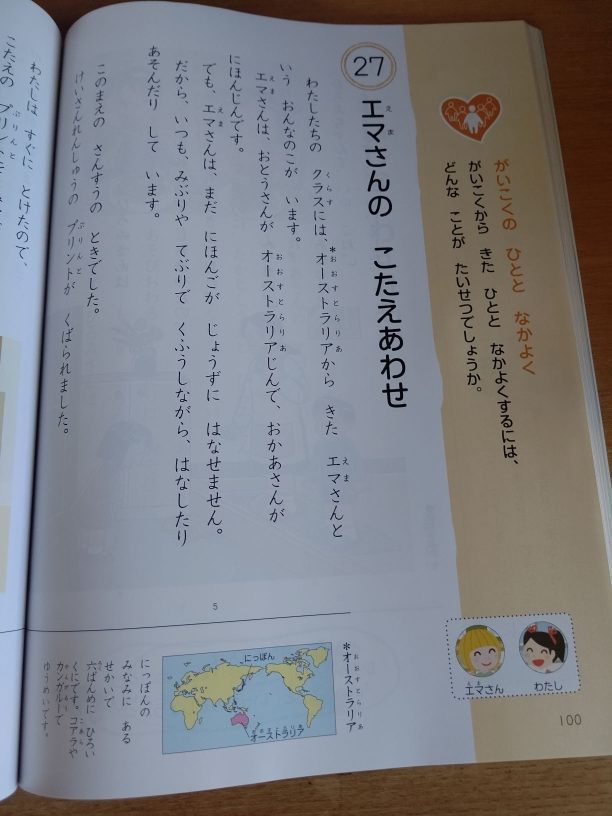
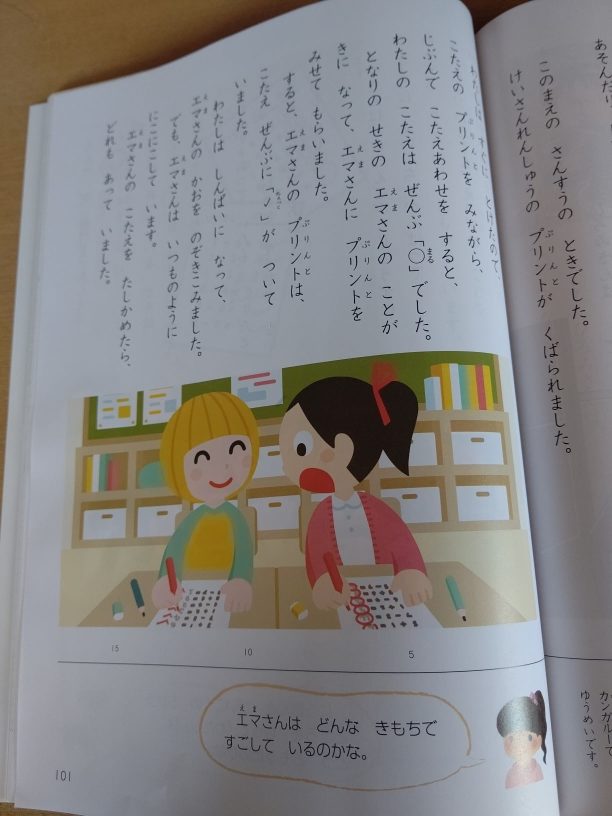
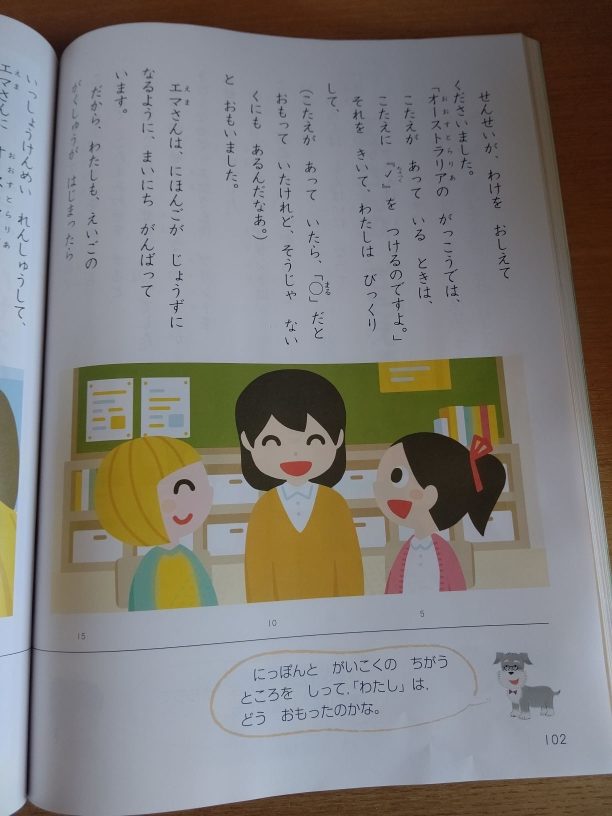
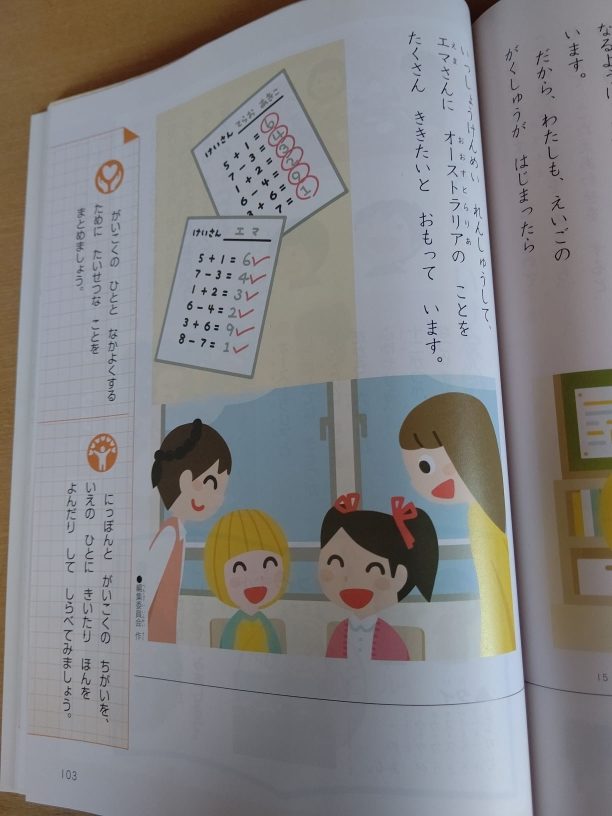
40 comments on “Problematically racialized Education Ministry-approved primary-school “Morals” textbook: “Shōgaku Dōtoku: Yutaka na Kokoro 1-nen” (Kōbun Shoin, 2020)”
XY and Dr. Arudō, thanks for sharing. The first section mentioned needs to be considered in the context of the entire text. If non-Asian people are universally depicted in a negative light, that should be stated. However, the “goddess” is clearly depicted as a white woman, so I’m not horribly moved by the depiction of the “dishonest man” as white.
On the other hand, the story about “Ema” is disgusting on multiple levels. If they wanted to make it a story about how to deal with immigrant children, there would be no need to make the immigrant child’s mother Japanese. Clearly, the authors want us to think that mixed-race Japanese are not real Japanese. What is particularly bothersome about it is the conclusion it reaches–suggesting “Akiko” (the main character) will somehow learn enough English quickly enough to be able to competently communicate with “Ema” before “Ema” could be expected to become competent enough in Japanese for the two of them to communicate in Japanese. The text even attempts to present “Akiko’s” studying of English as equivalent to that of “Ema” studying “Japanese” (not kokugo). Give me a break! There is no such comparison. “Ema” is a Japanese girl living in Japan attending Japanese school. Are we seriously supposed to imagine that by sixth grade her Japanese will not be as adequate as “Akiko,” who will have undergone a meager 160 hours or so of “English instruction,” likely conducted by someone who cannot actually speak English? Even if “Akiko” aces her English instruction at elementary school, at best she will be able to make simple sentences with simple vocabulary. Absolutely ridiculous.
The pretense of “Ema” using a check mark instead of a circle to denote correct answers is also completely absurd. The girl is supposed to be a first grader. Where did she learn to use check marks if she’s just now entered the first grade? Why does she understand when her teacher instructs her to do marutsuke, yet fails to actually use circles? Someone with experience in Australian schools will need to confirm, but I also have a hunch that Australian schools (although “Ema” presumably did not attend one) do not make students grade their own answers. All that aside, are we supposed to believe that “Ema” is so dense that she doesn’t notice that all the children around her are using circles instead of check marks and that the teacher does the same?
Further, if we’re going to talk about morals, where is the lesson about helping people like “Ema,” who cannot speak Japanese very well, learn to become competent Japanese speakers? Instead, the clear message is, “Let’s use people who can speak English as free English practice.” This is the only thought “Akiko” jumps to, and the text makes no attempt to point out why it’s wrong. Worse still is that the other conclusion–that “Ema” uses checks instead of circles because she is “gaikoku no hito“–completely skips past the obvious teaching point that some people do some things differently simply because we are all individuals, and that’s okay. And yet Monbukagakushō has the nerve to talk about encouraging the growth of students’ “rich individuality” and so forth. Completely repugnant hypocrisy.
Finally, of course, despite the fact that “Ema” is Japanese, her name is written in katakana, with no last name, because of course, “That’s how ‘gaikoku no hito‘ write their names.” I think my eyes rolled so hard they fell out of their sockets.
Things like these are one of the reasons why I really dislike it when anyone (J or NJ) claims that many of the problems NJ experience in Japan occur because “Japanese people aren’t used to foreigners”. No. While a fear of the other is natural, preconceptions are formed through experience and indoctrination. The makers of such materials don’t create them in a vacuum and their decisions are made consciously.
I think the first story can be seen as a caricature of not only a westerner but also a man who dares to grow a beard. Because, as we all know, people with beards are scary. That reminds me how, in some of the places where I worked with preschool children, my beard seemed to bother staff (perhaps because of parents) while the children didn’t care. Again, preconceptions are learned.
The second one, I think, is more insidious because it’s done under the veneer of kindness. Children, obviously, won’t approach the story critically. What’s worse, however, is that pointing out its problematic aspects to adults can also be very tricky because the message is to “be nice to the gaikoku no hito”.
Before even getting to talk about how this type of portrayal can make life hard for mixed-race and NJ people, you’d often need explain all the things XY is pointing out first.
When I attempt to have conversations on this kind of topic, more often than not the other person’s response includes the word “shimaguni”, which brings us back to square one.
Thanks for bringing this up though. It’s published at state level, which means there’s probably very little that can be done. But I still think it’s good to share these things and not leave them unaddressed, albeit only online.
Racism and othering. That’s all Japan’s got. So ‘omotenashi’.
Japan only gets the international pass from news media because its internationally irrelevant and doesn’t scare anyone.
And because its “Asia’s only functioning democracy” and an anti communist bulwark. The former is an out of date false cliche and the latter assumes post fascism really is a price worth paying for having an island chain against post communism/national socialism
Plus the J products are Kawaii, and admittedly better quality than anything coming out of China, except for the Sony Timer, but I digress.
Its funny how some Japanese feel an urge to say e.g. middle eaterners are “not like us” and yet still admit they can’t exercise freedom of speech, or give less than six months notice to a job despite their enshrined rights (ignored).
So much for the western illusions.
It is cruel because half-Japanese I have taught have been better at Japanese than their other parent’s language, but can get judged by the way they look. As if they are not pure enough.
To me if they grow up in Japan, as I have seen, they act and speak Japanese fluently but not the other parent’s language as well.
It is very hard to be truly bilingual.
Perhaps certain “halfu” sports celebrities could add their opinions and experiences on this, but it seems these days they would rather avoid these battles and choose more “with the times” political narratives
im sure, at least the halfu that I have worked with or have been around, would appreciate being noticed and stood up for by those with the means to do so.
Couldn’t agree more. Again (for the upteenth time) where is Naomi Osaka?!?
Crickets.
— I think at this point it’s clear she’s in it for the money. No need to upset the apple cart, since in Japan to her it’s only an issue of “a few bad apples“, not something widespread and systemic.
What a can of worms!
I agree The Honest Woodcutter is problematic in its execution here.
The story is from Aesop but, like the Tortoise and the Hare, the Japanese have “appropriated” it (How many Japanese know that the Tortoise and the Hare is not a Japanese native tale?)
The goddess is modeled on Athena (the Japanese will tell you Minerva), although this is a gender change from the original Hermes – the Japanese deciding that a water deity must be a woman.
Anyway, what is relevant to this is, as the original submitter stated, there is a clear racial difference made between the honest woodcutter and the dishonest one. The honest one is drawn like a typical Japanese character – look at his face in profile as opposed to the dishonest one. The dishonest woodcutter is drawn as a caucasian.
And the mess that is Ema?
Marking using ticks (OK, possibly due to environmental background) is NOT a question of language ability. Ema could have started school in Australia (reception year at 5 years old) which could have affected her language abilities. However, one would have to ask how the teacher made it clear to her that she was supposed to mark her sheet? And how do all the other kids in the class know how to mark their sheets? Are we to presume that drawing circles is genetic?
Of course, like virtually all NJ portrayed in textbooks in Japan, Ema is just a generic character created by the publishers with a nationality tacked on.
Notice that the only information given about Australia in the little info box is that koalas and kangaroos live there.
Oh, and the “I have to learn English to be nice to the foreigner” platitude is annoying as hell.
Isn’t it ringing alarm bells somewhere that people who make textbooks don’t seem to have studied education?
Let me suggest Ema is Australian, not Japanese. She has a Japanese mother, which qualifies her for Article 2(1) of the Nationality Statute. However, she has an Australian father and since she came from Australia, it is probable that she was born there. Australian Citizenship Act of 2007, Part 2, Division 1, Section 12(1)(a) applies and Ema automatically acquires Australian citizenship. This in turn engages Article 12 of the Nationality Statute to cause Ema to lose her Japanese nationality unless her parents comply with the stipulated procedure, which engages Article 104 of the Family Registry Statute. Art 104 requires registration and indication of volition within three months of birth, and we may infer that this was not done because they are in Australia. The failure to ratify her nationality within the prescribed period causes Ema to lose Japanese nationality and thus to say she is Gaikoku-no-hito is correct.
— We got ourselves a live Gaijin Handler, folks! I guess somebody in the GOJ saw this blog post and sicced him on us. (It’s not the first time he’s come here to Gaijin Handle, either.)
This is an extremely flawed argument grounded in odd presumptions and disingenuous readings of the law.
1) You’re assuming that someone in Japan with one NJ parent was born overseas just because she spent time overseas.
2) Even if the child was born in Australia, you’re assuming her parents didn’t comply with registering their child after birth with the Japanese authorities at a Japanese consular mission abroad. (They have those in Australia, you know.) I daresay most if not practically all do (as, for example, Alberto Fujimori’s parents did, Japanese citizens living and working overseas do, and every single Japanese/NJ couple I have ever known who gave birth to their child overseas did), since they would be aware that not doing so would rob them of Japanese nationality. So you may not infer that was not done. It’s done every day.
3) With proper Japanese registration, Japanese-NJ dual nationality is permissible until the 22nd birthday of the child. Australian law on citizenship has no bearing on Japanese law of citizenship, so your citing it is a red herring.
Therefore, chances are that this fictitious character with a Japanese parent is a Japanese citizen. Therefore a Nihonjin. Not a “Gaikoku no Hito”. However, if you’re still arguing that she is a “Gaikoku no Hito” by dint of the fact she has a mixed background, by logical extension you’re assuming that one has to be pure Japanese in order to be a Nihonjin. That’s not even Embedded Racism. Don’t go there.
In any case, this unrealistic fictitious character doesn’t belong in a child’s textbook. Because it produces pedants like you who will find any reason to exclude anyone who doesn’t meet your standards of bloodline. Go away.
Like Kazuaki says, if Japanese kids can’t be brainwashed by state propaganda to ‘other’, ostracize and bully other kids with discredited WWII nazi notions of ‘blood’ and ‘race’, well, I just don’t know how Japan as racist ethnostate can survive!
That’s the goal here, after all, isn’t it…?
Even if you assume that “Ema” is a rare case in which her parents didn’t file her birth timely with the Japanese authorities while living abroad, it’s utterly irrelevant to the problematic message this story carries, namely that of “hāfu” = gaijin. Such a message is just wrong. Dead wrong. It must not be passed down to the next generation of Japan, and especially not by ministry-approved materials.
To add to Debito’s comment. Even if the girl doesn’t have Japanese citizenship and even if both of her parents were Australian, labeling her as “Gaikoku no Hito” is just wrong and stupid. Such textbooks for children exist everywhere, I’ve seen textbooks like this in Germany for example. In Germany the authors would focus on the similarities, not the differences. For example the main character in the book would say things like “This kid has dark skin and maybe he doesn’t understand German very well, but playing football with him is as much fun as playing with the other kids”, or similar stuff. The textbook would probably also mention how important it would be to teach German to the kid and to assimilate him into German culture. The Japanese textbook meanwhile focuses on differences, even stupid ones like drawing a circle, or checkmark, and instead of assimilating the child into Japanese culture and teaching Japanese to her, the main character wants to learn English in order to communicate with “foreigners”. This tells you everything about how Japanese people view immigrants. That is as tourists who will only stay for a few years, therefore it’s not worth it to teach them any Japanese. This books perfectly represents how Japanese society views immigrants. And that’s why it’s problematic. Quoting laws about nationality and debating about the true nationality of a fictional character is pointless, the important part here is what the authors are trying to tell schoolchildren with this story.
@Niklas
+1
Slight tangent but I learnt Japanese by seeing or imagining similarities with English to the point I am now convinced some Japanese is derived from English. For me some of the Hiragana/Katakana characters resemble English letters. And there are many words or expressions similar or the same in both languages.
And yet, my Japanese students lament how hard English is because its “different”/ While surrounded by thousands of English loan words in their daily lives.
“Look for similarities not differences” but I am sure this fell on deaf ears.
Its going to take a hundred years or more to right this wrong.The wrong myth of Japanese uniqueness and exceptionalism taught while nation building and again post war (honne tatemae being one such recent contruct actually).
– debating about the true nationality of a fictional character is pointless
Ah yes but its this kind of focus on semantics and “what kind of person they are” that many Japanese love to do. So its not usually a case of “His policies seem good/bad” but rather “He seems like a nice guy/no beard/in a suit/looks “majime”) etc or “he is the kind of person who can say no/gaman dekiru etc.
A preference for character traits as opposed to universal rules or mores. This is probably seen as “human” or flexible”. The result is outcomes wholly depend on who you get as a judge, immigration officer or whatever. Similar to daily life in mainland China actually (way to go Japan!).
Wow, bringing up national constitution of foreign country to a make fictitious story semi-authentic. This Japanese dude seems to think that “pure Japanese’ fallacy is appropriate for first-graders?
You missed out on the most important point which is that even if her parents forgot to “register” her birth and she doesn’t have a Japanese passport, she still has a Japanese parent and is therefore still Japanese.
My dad is from Brazil. I don’t have a Brazilian passport, pretty sure I’m still part Brazilian.
“— We got ourselves a live Gaijin Handler, folks! I guess somebody in the GOJ saw this blog post and sicced him on us. ”
My comment is for Debito, not Kazuaki. I have been getting your emails for nearly two decades, and though I don’t often comment, I’ve been moved enough to take time out of my day to write this.
I hope you will see my comments here as constructive. When I read your comment, I felt anger at your choice of words for Kazuaki. He has taken the time to put forth a thought-out comment here. His comment has no ridicule nor offensive tone that I can detect and is simple and straightforward. But yours? To me it looks hypocritical among posts about bullying in the same newsletter, and, as a long-term reader and someone who supports your overall goals as an activist, I felt alienated because I want this website to show respect for others even when there is disagreement.
In fact, if the quality of your rebuttal is good, then the entire case against this textbook is improved—so why not thank Kazuaki for sharing? His suggestion could very well be something the authors might say if questioned.
“[Y]ou’re assuming that one has to be pure Japanese in order to be a Nihonjin.” I don’t see that in his statement. I read it as meaning that the authors could justify their position via this (unlikely but perhaps possible) scenario of Ema not having Japanese nationality. (The three-month clause is actually a serious issue worthy of more comment since parents wishing to retain their child’s Japanese nationality have only that very slight window to protect it—with very serious consequences if anything prevents them from filing.)
Kazuaki has simply offered a viewpoint with some information. Disagree with his point. Refute his argument. Why go further?
— Because I think there’s more going on behind what he’s doing besides expressing simple disagreement. That is to say, he’s not just pointing things out. He’s supporting the exclusionary ideology behind the textbook for children (little kids, remember, which is dirty pool in itself) through presumption, pedantry and red herrings.
If my further labeling of this activity as “gaijin handling” (or using the name “gaijin handler”) is what’s upsetting you, fair enough. In terms of intellectually honest debate, that’s probably beyond the pale. Sorry. Thank you for the constructive comment.
Thank you, Debito. Yes, my personal interest is more in intellectually honest debate, as you put it.
I also find that trying to understand deeply what the textbook authors, for example, were thinking and why some people might support such a story can be more useful for effecting change than just calling foul.
They are just following the publicly available policy that Japan does not consider Japaneseness to be based on the country of birth, but on the bloodline. (P.S. male bloodline is the key – that’s why the emperor can’t be female, it is the important Y chromosome that can be traced all the way back to Korea.)
You can have a Japanese passport but still be a gaijin in the eyes of Japan. No one can dispute that.
— We can. And should. As parents protecting our children from Embedded Racism. Especially when Japanese citizens with diverse roots have their very identities at stake due to lessons from a First Grader textbook!
The limitation that only fathers can pass on Japanese citizenship was rightfully abolished in 1985, and the concept of that limitation has to vanish out of the public mind, too.
But then, not even the pre-WWII concept of wifes automatically taking the citizenship of the husband has completely vanished here (ask my wife how often she got asked by friends and colleagues “are you [husband’s nationality] now?” after marrying me), but I digress.
Anyway, nice side blow with the notion that the imperial family stems from Baekche nobility 🙂
Yes, you can and should rally against the persons and institutions who proscribe and deny cultural identity based on presumed DNA (I say presumed, because all of these otherings are based on non-scientific means such as looks or names). I was just pointing out what happens in real life. It is wrong but undeniable that it happens.
— Okay. Thanks for the clarification.
Nicklas: ‘The Japanese textbook meanwhile focuses on differences’.
You should do a bit of reading on ‘the narcissism of small differences’, not so much the original concept, expressed by Freud, but the modern concept, expressed by writers like Clive Hazell and Chris Hitchens. it really does explain how a so un-unique culture, like Japan, is obsessed with promoting its own sense of uniqueness to itself and to others.
I remember once waiting for my coffee at a Starbucks in Tokyo and these two snr high school girls were alongside me, doing likewise. One was explaining to the other her personal experience of the differences between getting a coffee at Starbucks in Japan and getting a coffee at a Starbucks in the United States. The girl listening was totally stunned and exclaimed, ‘what! they have Starbucks in America now!!!’
‘what! they have Starbucks in America now!!!’ – This is just dumb ignorance and also late stage postmodern simulation coupled with the usual kleptomania of foreign culture. Tempura is Japanese (wrong, Portuguese). Gyoza is Japanese, etc.
Also brand obssession and acquisition whereby the original is replaced by a copy, and then the copy is preferred. In the third phase
“pretends to be a faithful copy, but it is a copy with no original”
In the final stage, “where cultural products need no longer even pretend to be real”
I told a J student of mine about how apples from the UK had spread Covid and he said “Eh? I pad and I phone spread Covid?” Ie. his first thought of “apple” is the product, not the fruit, depsite the context of the prior conversation.
Ditto in Japan the ladies who want to get married dressed as a “Disney Princess”. Not a copy of a real princess, but one of a fictional cartoon character.
I have digressed, but the point in Japan is merely following global and particularly American brands slavishly in their daily mentalities, which makes it more global junk culture, a brand in itself, rather than a “unique culture”.
As I have mentioned before, even so called “uniquely Japanese” peculiarities are often recent constructs- e.g. Honne/tatemae being of post WW2 origina so arguably American influenced in some way. (Doi, T. The Anatomy of Self 1985. P. 35).
“Though tatemae and honne are not a uniquely Japanese phenomenon, some Japanese feel that it is unique to Japan; especially among those Japanese who feel their culture is unique in having the concepts of “private mind” and “public mind”. ” LOL. (ps. Its also Chinese).
Sounds familiar. In my case it was a seiyuu being surprised about the US having a KFC on her radio show and then talking about how different the French fries tasted there. Sometimes I wonder if some Japanese people think that every company operating in Japan is a Japanese company. And thank you for the reading advice, I will try to look into it, sounds like that particular theory could explain a lot of things that are going on in Japanese society. Especially all the “japansplaining” about the uniqueness of Japanese culture.
Yes, the narcissism of small differences explains a lot about what Japan, China and Korea hate each other so much.
i think thats why nit picking, pretentious fake art appreciation flourishes so much in Tokyo, e.g. experimental “musicians” who play air guitar, or a sine wave drone, or those who choose to learn French for snobbery reasons rather than legitimate communicative needs. Only a society that perceives itself as so middle class would spend so much time “admiring the lace of the curtains when there are no windows” to paraphrase a review of Mishima post 1945.
Or the Japanese customer who complained his delivery from China hadnt included “〒” as in e.g. 〒100-0001, even tho it was on time.
People with too much time on their hands. The narcissism of small differences indeed.
“Do the western teachers know how to use the (western) toilet?” Tokyo, 1990.
Will never forget this classic.
“Moral Education” is a dodgy subject at the best of times. Teachers complain that it is the only subject for which they have to follow a vey specific lesson plan. The topics are often unrealistic or the “morals” are lacking.
What’s worse is that every other subject has to contain elements of the overall moral education curriculum, which of course begs the question of why bother having it as a separate subject.
One of the results of this is an increasing volume of “Japansplaining” in the English textbooks. This also explains why virtually every JHS or HS textbook has a Hiroshima story.
Over the last couple of versions of the textbooks I have noticed more and more Japanese vocabulary sneaking into the main text.
The textbooks used at elementary level all contain talking about Japan (when kids still don’t have the English to talk about their family), complete chapters on the Tokyo Olympics (remember, these were published pre-covid – in other words, they were still going to be talking about the Tokyo Olympics for the lifespan of the textbooks, which is typically four or five years), and more trying to sneak “mottainai” into the English language. (I have already encountered it in some JHS level listening tests)
These books often have a cast of international characters, who are just “generic” (made to fit the Japanese idea of what a foreign person is like) and with a nationality tacked on as an afterthought, and are almost always voiced/acted by Americans.
Anyway, the end result is the teacher often spending lesson time explaining Japanese stuff in Japanese during an English lesson. Not to mention the not-so-subtle hints that “we are unique and therefore superior”.
This.
In the absence of any real NJ to talk to (because Japan just not such a great choice for NJ looking to make a go of a new country), in the absence of any desire to talk to real NJ (abunai!), in the absence of any ability to communicate effectively in English (J-education system, that’s on you!), what have these textbooks become?
They are no more teaching English than any of the other ‘symbols’ purporting to possess purpose in Japan (a land where women can ‘shine’ and ‘we Japanese are all middle class’. Baudrillard would approve.
They don’t teach Japanese kids to expand their minds and horizons through communicating with NJ, in fact they do the exact opposite; they indoctrinate Japanese kids in ethno-nationalistic worldviews that will narrow their minds and opportunities to experience the world- perfect goal of the ‘erai hito’.
It all makes sense.
It all makes NONsense actually. That is to say, Japanese is a language used as often to Obfuscate the meaning rather than to communicate. Thus, Uso Mo houben, actually a lie is a means to not exclusively a selfish end, a white lie, to avoid upsetting the other person as well. Though I would argue its a “win win” because the listener isn’t offended and the speaker avoids delivering bad news and wasn’t beheaded as a result.
Language in Japan especially Tatemae Tokyo, I have noticed, be it in English or Japanese, is used as a “tool” to create an impression or favorable atmosphere rather than convey genuine meaning. You may have seen the host recruiting or selling beauty products to gullible young women outside Shibuya station, some of the stuff I overhead made no sense at all, but they were disjointed buzzwords that elicited an enthusiastic response; the girl was positively beaming from the attention,
So now “Genki Sports drink happy chocolate let’s enjoy!” is fine in Japan, because it does its job of conning people to buy it. Each word covers a specific base one needs to mention to provoke a response. “Genki” is a must in Japanese social situations, almost tyrannically. A salesman who had bought into this once said “If the teacher isnt genki, regardless of qualifications, forget it”. Ditto “Happy” as its part of the Dreamy Day illusion of social cohesion. “Lets” is an invitation that avoids asking a question so its harder to refuse.
So yes, the buzzwords are indeed “symbols” that elicit a response. Tokyo is like a marketing experiment writ large. LIke the Truman Show, everyone is supposed to be happy genki so lets ignore that pesky radiation etc, its “Shouganai” after all.
Bringing it back to the ethno nationalism kids are taught, reminds of something s professor said “You had better teach kids a rule to memorize at that age” so they are given simplistic generalizations of a world view.
There is a very patronizing view top down in all industries in Japan, from music to language learning to politics, that the “plebs” need something easy to understand and dumbed down.
I wanted to add to this that indirect expression, eg. the salesman giving info rather than pushing a sale, may be presented as “polite to the customer” but its actually gutless, rude and self serving, as the customer than has to work hard sifting thru the details what the pros and cons actually are, but I have digressed.
I also noticed the staggering difference between foreign language textbooks in Japan and my home country. In Japan, their stories are all situated in Japan. In my home country, their stories are all situated in the country where the language is actually spoken. English textbooks have settings in Britain, America, and Australia, French textbooks have settings in France. Heck, even Latin textbooks’ contents revolves around the long gone country where the language was actually spoken. Those setups have the advantage that they aren’t only teaching the language, but also about the respective countries and their customs and culture. I find the approach of Japanese foreign language textbooks to have their stories taking place in Japan pointless. When I point this out, the standard excuse is that almost all Japanese kids know nothing else but life in Japan and therefore a textbook with contents showing life in another country would be too overwhelming. Let that sink in.
I never thought about that. Yes. My French language textbook in HS was about a family in France and followed their daily lives.
I’ve seen a few Japanese English texts and they are all about Japanese people doing Japanese things – actually heavily re-enforced by having sentences that say things like, in the absence of any other context, “Japanese people eat rice”.
Yep, because the goal of “English education” in Japan is not understanding others; it is “helping others achieve the correct understanding of Japan,” use of article “the” intentional.
Well, yeah.
Just like the goal of the JET Program isn’t to expose Japanese kids to NJ, it’s to evangelize NJ into pro-Japan mouthpieces.
To be a perpetual tourist and/or to be on an extended vacation and write drivel like this to the folks back home:
https://www.irishtimes.com/life-and-style/abroad/among-the-japanese-public-the-olympics-is-a-dirty-word-1.4564104
“Inevitably, though, the pandemic casts a shadow over my Japanese adventure.”
Poor boy, the pandemic spoiled his “Japan adventure.” I wonder if these people end up doing more harm than good.
I neglected to point out in my comment above that some of the elements of moral education that needs to be included are “love for country”, “love for locality”, etc.. Maybe some of you remember the case of the textbook a few years back that changed the setting from a bakery to a Japanese sweets shop to be sure that it was fulfilling these points.
Yet, somehow “international understanding” seems to get its box ticked by the Hiroshima stories.
Go figure.
Another thing, I just noticed how strange it was to use furigana on katakana words. Don’t kids learn both at the same time? It really just emphasizes the otherness of it all.
— I think kids learn hiragana first, no?
Just my observations and only anecdotal evidence, so take with a grain of salt. Kids learn Hiragana first in elementary school, but at this point it’s only learning of how to write them “properly”. Most kids learn reading both Kana sets at a preschool age, but some might have trouble recognizing or telling apart some Katakana because those appear way less frequently. It’s at least very common for preschool children’s story books to have Furigana added to Katakana.